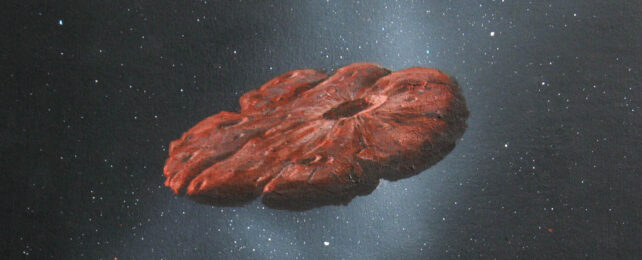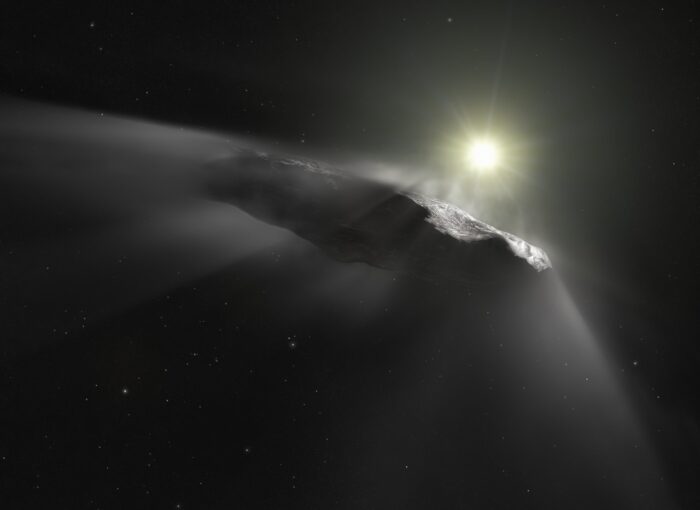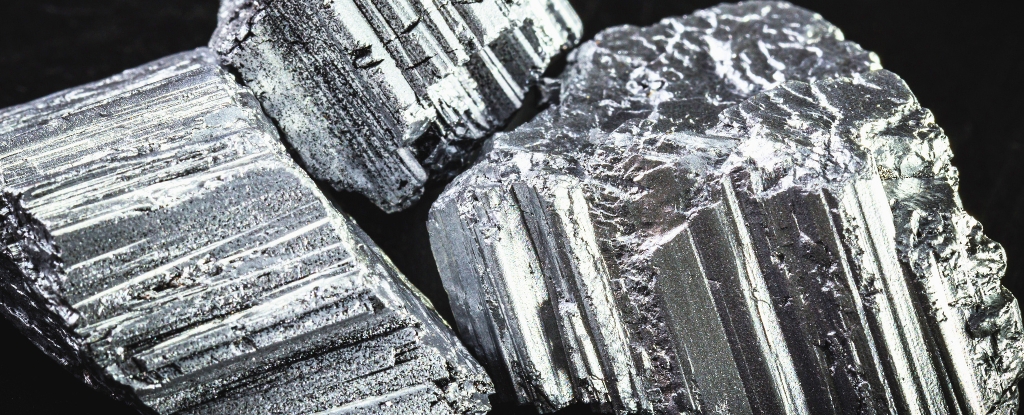ARTICLE AD
 Artist’s Concept of ‘Oumuamua. (William Hartmann)
Artist’s Concept of ‘Oumuamua. (William Hartmann)
On October 19th, 2017, astronomers with the Pan-STARRS survey detected an interstellar object (ISO) passing through our Solar System for the first time. The object, known as 1I/2017 U1 Oumuamua, stimulated significant scientific debate and is still controversial today.
One thing that all could agree on was that the detection of this object indicated that ISOs regularly enter our Solar System. What's more, subsequent research has revealed that, on occasion, some of these objects come to Earth as meteorites and impact the surface.
This raises a very important question: if ISOs have been coming to Earth for billions of years, could it be that they brought the ingredients for life with them?
In a recent paper, a team of researchers considered the implications of ISOs being responsible for panspermia – the theory that the seeds of life exist throughout the Universe and are distributed by asteroids, comets, and other celestial objects.
According to their results, ISOs can potentially seed hundreds of thousands (or possibly billions) of Earth-like planets throughout the Milky Way.
The team was led by David Cao, a senior student at Thomas Jefferson High School for Science and Technology (TJSST). He was joined by Peter Plavchan, an associate professor of physics and astronomy at George Mason University (GMU) and the Director of the Mason Observatories, and Michael Summers, a professor of astrophysics and planetary science at GMU.
Their paper, "The Implications of 'Oumuamua on Panspermia," recently appeared online and is being reviewed for publication by the American Astronomical Society (AAS).
To briefly summarize, panspermia is the theory that life was introduced to Earth by objects from the interstellar medium (ISM). According to this theory, this life took the form of extremophile bacteria capable of surviving the harsh conditions of space.
Through this process, life is distributed throughout the cosmos as objects pass through the ISM until they reach and impact potentially habitable planets. This makes panspermia substantially different from competing theories of how life on Earth began (aka. abiogenesis), the most widely accepted of which is the RNA World Hypothesis.
This hypothesis states that RNA preceded DNA and proteins in evolution, eventually leading to the first life on Earth (i.e., which arose indigenously).
But as Cao told Universe Today via email, panspermia is difficult to assess:
"Panspermia is difficult to assess because it requires so many different factors that need to be incorporated, many of which are unconstrained and unknown. For instance, we must consider the physics behind panspermia (how many objects collided with Earth prior to the earliest fossilized evidence for life?), biological factors (can extremophiles endure supernova gamma radiation?), and so on.
"In addition to each of these factors are questions we do not have answers to yet, or we cannot model effectively, for example, the number of extremophiles that actually reach the Earth even if a life-bearing object collided with Earth, and the probability that life can actually start from the foreign extremophiles. The collection of these factors, along with many more, such as the changing star formation rate and the recent detection of several rogue free-floating planets, makes panspermia difficult to assess, and therefore, our understanding of the plausibility of panspermia is constantly changing."
 Artist's impression of the interstellar object, `Oumuamua, experiencing outgassing as it leaves our Solar System. (ESA/Hubble, NASA, ESO, M. Kornmesser)
Artist's impression of the interstellar object, `Oumuamua, experiencing outgassing as it leaves our Solar System. (ESA/Hubble, NASA, ESO, M. Kornmesser)The detection of 'Oumuamua in 2017 constituted a major turning point for astronomy, as it was the first time an ISO was observed.
The fact that it was detected at all indicated that such objects were statistically significant in the Universe and that ISOs likely passed through the Solar System regularly (some of which are likely to be here still).
Two years later, a second ISO was detected entering the Solar System (2I/Borisov), except there was no mystery about its nature this time. As it neared our Sun, 2I/Borisov formed a tail, indicating it was a comet.
Subsequent research has shown that some of these objects become meteorites that impact on Earth's surface, and a few have even been identified. This includes CNEOS 2014-01-08, a meteor that crashed into the Pacific Ocean in 2014 (and was the subject of study by the Galileo Project).
As Cao explained, the detection of these interstellar visitors also has implications for panspermia and the ongoing debate about the origins of life on Earth:
"Oumuamua serves as a novel data point for panspermia models, as we can use its physical properties, particularly its mass, size (spherical radius), and implied ISM number density, to model the number density and mass density of objects in the interstellar medium. These models allow us to estimate the flux density and mass flux of objects in the interstellar medium and, with these models, we can approximate the total number of objects that impacted Earth over 0.8 billion years (which is the hypothesized period of time between Earth's formation and the earliest evidence for life).
"Knowing the total number of collision events on Earth over that 0.8 billion-year period is vital for panspermia, as a greater number of collision events with interstellar objects over that period would imply a higher probability for panspermia.
"In short, the physical properties of the interstellar 'Oumuamua allow for the creation of mathematical models that determine the plausibility of panspermia."
In addition to the mathematical models that consider the physics behind panspermia – i.e., number density, mass density, total impact events, etc. – Cao and his colleagues applied a biological model that describes the minimum object size needed to shield extremophiles from astrophysical events (supernovae, gamma-ray bursts, large asteroid impacts, passing-by stars, etc.).
As addressed in a previous article, recent research has shown that cosmic rays erode all but the largest ISOs before they reach another system.
These additional considerations ultimately affect the number of objects that will impact Earth (that were not sterilized by astrophysical sources) and the plausibility of panspermia.
"In order to derive the minimum object size, we applied various models, for instance, the sphere packing method to give a rough estimate of an ejecta's distance to the nearest supernova progenitor (using Orion A, a dense star cluster, as our model), the gamma radiation that reaches that ejecta, and the attenuation coefficient (how much radiation the ejecta absorbs) based on the most probable chemical composition of ejecta (water ice)," said Cao.
Based on their combined physical and biological models, the team derived estimates for the number of ejecta that struck Earth before life emerged. According to the oldest fossilized evidence found in western Australia (from rocks dating to the Archaean Eon), the earliest life forms emerged ca. 3.5 billion years ago. Said Cao:
"We conclude that the maximum probability that panspermia sparked life on Earth is on the order of magnitude of 10-5, or 0.001 percent. Although this probability appears low, under the most optimistic conditions, potentially 4×109 total habitable zone exoplanets exist in our Galaxy, which could indicate a total of 104 habitable worlds harboring life.
"Additionally, we restricted our analysis to the first 0.8 billion years of Earth's history prior to the earliest fossilized evidence for life, but because life can be seeded at any point in a planet's lifetime, and planets have significantly longer habitable lifespans (up to 5-10 billion years), we boosted our estimate for the total number of habitable worlds harboring life in our Galaxy by one order of magnitude."
From this, Cao and his colleagues obtained a final result of about 105 habitable planets that could harbor life in our galaxy. However, these estimates are based on the most optimistic projections regarding planetary habitability.
In other words, it assumes that all Earth-sized rocky planets orbiting within habitable zones are capable of supporting life, meaning they have thick atmospheres, magnetic fields, liquid water on their surfaces, and all life-bearing ejecta that survive entering our atmosphere are capable of depositing microbes on the surface.
frameborder="0″ allow="accelerometer; autoplay; clipboard-write; encrypted-media; gyroscope; picture-in-picture; web-share" allowfullscreen>
As Cao summarized, their results do not prove panspermia or settle the debate on the origins of life here on Earth. Nevertheless, they provide valuable insight and constraints on the possibility that life came here via objects like 'Oumuamua.
No matter what, these findings are likely to have significant implications for astrobiology, which is becoming an increasingly diverse field:
"We incorporate physics, biology, and chemistry into studying panspermia as the origin of life, and it is rare to have such a diverse range of topics in one research area. I think that astrobiology is trending toward becoming more interdisciplinary, which I believe is a positive trend because it would allow experts of all backgrounds to advance astrobiology.
"Our research may contribute to this trend. In terms of our findings on panspermia, the probability that panspermia sparked life on Earth is unlikely, but the number of habitable zone planets harboring life in our Galaxy is substantially larger.
"Future astrobiology studies may use these findings to build on our research on panspermia. However, we do not incorporate or even know all factors that may affect the plausibility of panspermia.
"I believe our findings open up new lines of inquiry for future panspermia studies to build off of by updating our models or incorporating additional factors.
"One potential area of study if we do find evidence for life on other worlds in the future, whether in our Solar System or via biosignatures in exoplanet atmospheres, is to consider experimental and observational tests to distinguish between life that arrived by the panspermia mechanism or life that evolved and arose independently."
This article was originally published by Universe Today. Read the original article.

 1 year ago
101
1 year ago
101 

